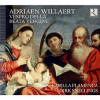Texte paru dans: / Appeared in:

Fanfare Magazine: 36:2 (11-12/2012)
Pour
s'abonner / Subscription information
Les abonnés à Fanfare Magazine ont accès aux archives du
magazine sur internet.
Subscribers to Fanfare Magazine have access to the archives of the magazine
on the net.
Ricercar
RIC325

5400439003255 (ID238)
Consultez toutes les évaluations recensées pour ce cd
~~~~ Reach all the evaluations located for this CD
Willaert didn’t create the double-choir psalm, though for the longest time he was credited with it. Examples exist that were composed earlier in the 16th century in the Venetian-controlled towns of Bergamo and Treviso, and earlier still at the Court of Ferrara in the 1470s. It was Willaert’s published collection of these psalms specifically for Vespers in 1550, however, that first drew attention to the genre, and where the man who had held the prestigious post of maestro di cappella at St. Mark’s in Venice for 23 years (and would continue to do so for another decade, until his death) traveled, other composers followed. Many similar collections immediately appeared and continued into the next century, of which Monteverdi’s is of course the most celebrated.
Willaert’s psalms demonstrate an increasingly sophisticated antiphonal treatment of the choirs. They no longer simply alternate verses (salmi senza riposte) between groups, but can overlap content slightly (salmi spezzati), and be performed by two differently composed choirs (salmi con le sue riposte)—one made up of soloists, the other employing multiple singers to one or more parts. This leads the Capilla Flamenca to abandon for this release its usual ensemble of four singers augmented by three gambists, a recorder soloist, lutenist, and organist, and settle instead on two countertenors, four tenors, a baritone, bass, and organist. (The organ is heard in interludes, not in the vocal selections.) The core group still consists of countertenor Marnix de Cat, tenor Tore Denys, baritone Lieven Termont, and bass Dirk Snellings, and functions as the soloists’ ensemble.
The presentation includes five of Willaert’s Vespers psalms. Three of these are actually collaborative efforts between Willaert and Jacques Colebault, better known in Italy as Jachet de Mantua. (They take alternate verses, employing contrasting contrapuntal techniques and meters.) These are interspersed—as they might have been in actual performance before the Doge in the Basilica of St. Mark’s—with other works, mostly motets by Willaert, including a simpler, spirited gem of a Magnificat, and almost inevitably an Ave maris stella with richly imitative writing of great beauty. Six interludes are supplied as well for solo organ, drawn from the ricercars and toccatas of both Willaert and Annibale Padovano, who functioned as first organist at St. Marks through Willaert’s last 10 years there, and the brief employment of his immediate successor, Cipriano de Rore.
Capilla Flamenca’s readings are spirited and precise. Each voice part is balanced with the others, while maintaining a textural clarity essential in music this complex. Enunciation is excellent. I would only note on the negative side that some minor vocal problems associated with Marnix de Cat’s intonation and tonal production in the ensemble’s last recording (secular works and Motets by Isaac, Ricercar 318, Fanfare 35:5) continue in this release. These are not frequently evident, however, and the overall effect of the group remains one of great focus and transparency.
In short,
this is a most welcome release, both for the seldom-heard Willaert Vespers,
and for another chance to sample the art of Capilla Flamenca.
Fermer la fenêtre/Close window
Cliquez l'un ou l'autre
bouton pour découvrir bien d'autres critiques de CD
Click either button for many other reviews


